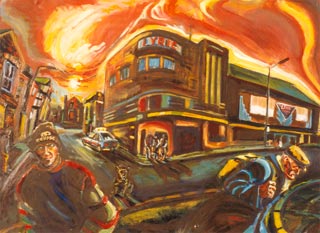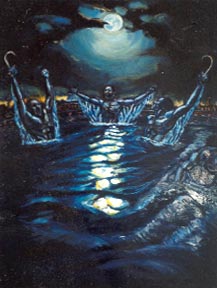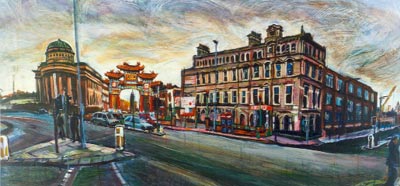
| HOME |
| NERVE |
| REVIEWS |
| ARCHIVE |
| EVENTS |
| LINKS |
| ABOUT US |
| CONTRIBUTORS |
| BACK ISSUES |
| CONTACT US |
 Artist
profile - John O'Neil
Artist
profile - John O'Neil
In my work I try to convey a sense of life in modern Britain, exploring themes like the male identity, shifting values, and modern leisure culture in post-industrial towns and cities.
My work - which is produced with oil on canvas - has a strong social content and I feel I tackle issues many choose to ignore. I think there is a lot of anger in my work, attitudes shaped by my upbringing in my native Teeside, and witnessing the lasting effects of Thatcherite policies throughout the 1980s. There was a complete evisceration of heavy industry within the North-East, and the impact still felt on communities today.
 One of
my paintings - The Show is Over? - deals with this experience. It refers
to Grangetown, my hometown. A lead oxide sun sets over a derelict art
deco cinema building, representing a nostalgic vision of the past, signalling
the end of an era, the passing of a 'working generation', and ultimately
the death of a community.
One of
my paintings - The Show is Over? - deals with this experience. It refers
to Grangetown, my hometown. A lead oxide sun sets over a derelict art
deco cinema building, representing a nostalgic vision of the past, signalling
the end of an era, the passing of a 'working generation', and ultimately
the death of a community.
Working in Liverpool I find it interesting to explore modern leisure culture. In the painting Bank Holiday Binge, I have updated a Francisco Goya painting of a religious festival - Pilgrimage to San Isidro 1821-23 - into a modern equivalent - getting blind drunk in the holiday period.
In the composition I make a composite of a group of revellers in chain of pubs, and use this to describe the increasingly multi-nationalised sameness of character and globalised experience in our towns and cities. I depict the crowd as one psychological mass and deliberately use a garish colour scheme to heighten the tacky carnival atmosphere that may border on violence.
 The sacked
Liverpool dockers' 28-month struggle provided inspiration for Resurgence,
which hangs in the Casa bar, Hope Street, which is run by former dockers.
In this painting I wanted to symbolise the spirit of resistance and empowerment
that the seamen and their families achieved.
The sacked
Liverpool dockers' 28-month struggle provided inspiration for Resurgence,
which hangs in the Casa bar, Hope Street, which is run by former dockers.
In this painting I wanted to symbolise the spirit of resistance and empowerment
that the seamen and their families achieved.
Liverpool's rich and varied architectural heritage provides inspiration for my cityscapes, and I find it interesting to compare the current regeneration in the city with the dilapidating grandeur of the past.